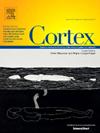Emotion-related impulsivity is related to orbitofrontal cortical sulcation
IF 3.2
2区 心理学
Q1 BEHAVIORAL SCIENCES
引用次数: 0
Abstract
Background
Emotion-related impulsivity (ERI) describes the trait-like tendency toward poor self-control when experiencing strong emotions. ERI has been shown to be elevated across psychiatric disorders and predictive of the onset and worsening of psychiatric syndromes. Recent work has correlated ERI scores with the region-level neuroanatomical properties of the orbitofrontal cortex (OFC), but not posteromedial cortex (PMC). Informed by a growing body of research indicating that examining the morphology of specific cortical folds (sulci) can produce unique insights into behavioral outcomes, the present study modeled the association between ERI and the morphology of sulci within OFC and PMC, which is a finer scale than previously conducted.
Methods
Analyses were conducted in a transdiagnostic sample of 118 adult individuals with a broad range of psychiatric syndromes. First, we manually defined over 4,000 sulci across 236 cerebral hemispheres. Second, we implemented a model-based LASSO regression to relate OFC sulcal morphology to ERI. Third, we tested whether effects were specific to OFC sulci, sulcal depth, and ERI (as compared to PMC sulci, sulcal gray matter thickness, and non-emotion-related impulsivity).
Results
The LASSO regression revealed bilateral associations of ERI with the depths of eight OFC sulci. These effects were strongest for OFC sulci, sulcal depth, and ERI in comparison to PMC sulci, sulcal gray matter thickness, and non-emotion-related impulsivity. In addition, we identified a new transverse component of the olfactory sulcus in every hemisphere that is dissociable from the longitudinal component based on anatomical features and correlation with behavior, which could serve as a new transdiagnostic biomarker.
Conclusions
The results of this data-driven investigation provide greater neuroanatomical and neurodevelopmental specificity on how OFC is related to ERI. As such, findings link neuroanatomical characteristics to a trait that is highly predictive of psychopathology.
情绪相关冲动与眶额皮质淤积有关。
背景:情绪相关冲动(ERI)描述的是在经历强烈情绪时自我控制能力较差的特征性倾向。研究表明,ERI 在各种精神疾病中都会升高,并可预测精神综合症的发病和恶化。最近的研究发现,ERI 分数与眶额皮层(OFC)的区域神经解剖特性相关,但与后内侧皮层(PMC)无关。越来越多的研究表明,检查特定皮层皱褶(沟)的形态可以对行为结果产生独特的见解,有鉴于此,本研究模拟了ERI与OFC和PMC内沟形态之间的关联,其尺度比以前进行的研究更为精细:方法:我们对118名患有各种精神综合症的成年人进行了跨诊断样本分析。首先,我们人工定义了236个大脑半球的4000多条沟。其次,我们实施了基于模型的 LASSO 回归,将 OFC 沟形态与 ERI 联系起来。第三,我们检验了OFC脑沟、脑沟深度和ERI(与PMC脑沟、脑沟灰质厚度和非情绪相关冲动性相比)是否具有特异性影响:LASSO回归显示,ERI与八个OFC沟的深度存在双侧关联。与PMC沟、沟灰质厚度和非情绪相关冲动性相比,这些效应对OFC沟、沟深度和ERI的影响最强。此外,我们还在每个半球的嗅沟中发现了一个新的横向成分,根据解剖学特征以及与行为的相关性,该成分可与纵向成分区分开来,从而可作为一种新的跨诊断生物标志物:这项以数据为驱动的调查结果显示,OFC与ERI的关系在神经解剖学和神经发育方面具有更强的特异性。因此,研究结果将神经解剖学特征与高度预测精神病理学的特质联系起来。
本文章由计算机程序翻译,如有差异,请以英文原文为准。
求助全文
约1分钟内获得全文
求助全文
来源期刊

Cortex
医学-行为科学
CiteScore
7.00
自引率
5.60%
发文量
250
审稿时长
74 days
期刊介绍:
CORTEX is an international journal devoted to the study of cognition and of the relationship between the nervous system and mental processes, particularly as these are reflected in the behaviour of patients with acquired brain lesions, normal volunteers, children with typical and atypical development, and in the activation of brain regions and systems as recorded by functional neuroimaging techniques. It was founded in 1964 by Ennio De Renzi.
 求助内容:
求助内容: 应助结果提醒方式:
应助结果提醒方式:


